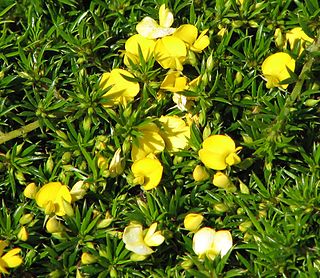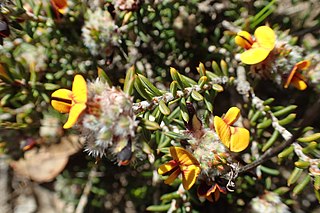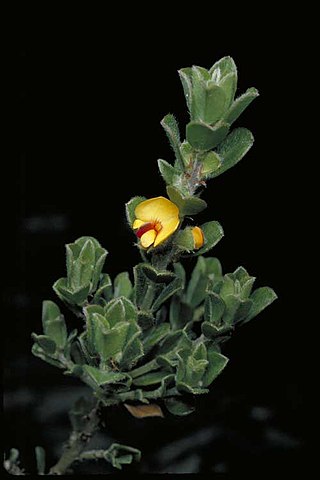
Eremophila subteretifolia, commonly known as Lake King eremophila, is a flowering plant in the figwort family, Scrophulariaceae and is endemic to Western Australia. It is a creeping, prostrate shrub with narrow, sticky, dark green leaves and distinctive orange-red to yellow flowers. It is a rare plant which grows near the edges of salt lakes.

Pultenaea pedunculata, commonly known as matted bush-pea, is a species of flowering plant in the family Fabaceae and is endemic to south-eastern Australia. It is a prostrate, densely matted shrub with softly-hairy branches that often form roots, narrow elliptic leaves, and bright yellow and brick-red flowers.
Kunzea acicularis is a flowering plant in the myrtle family, Myrtaceae and is endemic to the south-west of Western Australia. It is a shrub with a few erect stems, small and groups of three to five, pink to mauve flowers. It is a rare, recently described species only known from a small area near Ravensthorpe.
Hibbertia atrichosepala is a species of flowering plant in the family Dilleniaceae and is endemic to a restricted area in the south-west of Western Australia. It is an upright shrub with crowded linear to tapering leaves and yellow flowers arranged singly in leaf axils with glabrous sepals and the five stamens all on one side of the two carpels.
Pultenaea pauciflora, commonly known as Narrogin pea, is a species of flowering plant in the family Fabaceae and is endemic to the south-west of Western Australia. It is a dense, erect, much-branched shrub with sickle-shaped leaves with a sharp point on the tip, and uniformly yellow flowers.
Pultenaea adunca is a species of flowering plant in the family Fabaceae and is endemic to the south of Western Australia. It is an erect, spindly shrub with hairy, needle-shaped leaves and yellow and red flowers.
Pultenaea arida is a species of flowering plant in the family Fabaceae and is endemic to the south of Western Australia. It is a low, spindly, spreading shrub with small, flat, hairy leaves and yellow, red or orange flowers.

Pultenaea barbata is a species of flowering plant in the family Fabaceae and is endemic to the south of Western Australia. It is a prostrate or spreading, spindly shrub with hairy, needle-shaped leaves and yellow, red, orange or brown flowers with red or yellow markings.
Pultenaea brachyphylla is a species of flowering plant in the family Fabaceae and is endemic to the south of Western Australia. It is an erect, spindly shrub with cylindrical, grooved leaves and yellow, orange and brown flowers.
Pultenaea calycina is a species of flowering plant in the family Fabaceae and is endemic to near-coastal areas in the south of Western Australia. It is an erect, spindly shrub with flat or more or less cylindrical, grooved leaves and yellow and orange flowers.
Pultenaea craigiana is a species of flowering plant in the family Fabaceae and is endemic to near Ravensthorpe in the south of Western Australia. It is an erect, spindly shrub with densely hairy young stems, egg-shaped leaves with the narrower end towards the base, and yellow and red flowers.

Pultenaea elachista is a species of flowering plant in the family Fabaceae and is endemic to southern Australia. It is an erect, spindly shrub with hairy foliage, oblong to egg-shaped leaves with a pointed tip, and yellow flowers with red or orange markings.

Pultenaea empetrifolia is a species of flowering plant in the family Fabaceae and is endemic to the south-west of Western Australia. It is a spindly, prostrate or spreading shrub with down-curved, cylindrical, grooved leaves and yellow to orange and red flowers.

Pultenaea heterochila is a species of flowering plant in the family Fabaceae and is endemic to the south of Western Australia. It is an erect, low-lying or prostrate shrub with hairy leaves and yellow and red flowers.
Pultenaea pinifolia is a species of flowering plant in the family Fabaceae and is endemic to the south-west of Western Australia. It is an erect, slender shrub with pine-like leaves and yellow-orange flowers with orange marks.
Pultenaea purpurea is a species of flowering plant in the family Fabaceae and is endemic to the south of Western Australia. It is a small prostrate shrub with cylindrical leaves and yellow-orange and red flowers.
Pultenaea strobilifera is a species of flowering plant in the family Fabaceae and is endemic to the south-west of Western Australia. It is an open to dense, domed or spindly, erect shrub with simple leaves and yellow-orange and salmon pink to bright pink flowers.
Pultenaea vestita, commonly known as feather bush-pea, is a species of flowering plant in the family Fabaceae and is endemic to south-western continental Australia. It is an erect to prostrate, sometimes mat-forming shrub with elliptic to linear or lance-shaped leaves, and yellow and red, pea-like flowers.
Pultenaea indira is a species of flowering plant in the family Fabaceae and is endemic to the south-west of Western Australia. It is an erect or low-lying shrub with plate-like or fissured bark near the base, densely hairy stems above, linear to lance-shaped leaves with the narrower end towards the base, and yellow, red and maroon flowers.
Stenanthemum notiale is a species of flowering plant in the family Rhamnaceae and is native to Western Australia, South Australia and Victoria. It is a small, erect to prostrate shrub with hairy young stems, egg-shaped leaves with the narrower end towards the base, and clusters of white to cream-coloured or greenish yellow, densely shaggy-hairy flowers.





